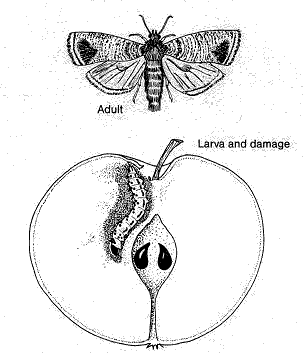Codling Moths
Tunnels in Apples, Pears and Apricots

The immature (larval) stage of the codling moth (Cydia pomonella) is the worm in "wormy apples." Codling moth also commonly damages pears and larger-fruited varieties of crabapples. Wherever these fruit trees are grown, codling moth is a serious problem and usually will need some treatment to protect the fruit.
A codling moth larva is 1 inch long and pink with a brown head. The adult is a grayish brown moth with lacy brown lines on its forewings and pale, fringed hind wings. It has a 3/4-inch wingspan. The larvae of codling moths tunnel their way through apples, pears, and apricots eating as they go. Their presence is signalled by visible cocoons in the bark crevices. Adult moths lay white, flat eggs singly on leaves, twigs, or fruit buds.
Codling moth has two or three generations per year. Adult moths first emerge (first flight) during midspring, usually around the period of full flower bloom. (Note: Never apply insecticides during periods of bloom. Treatments at this time will kill beneficial pollinators, such as honeybees.)
This first flight continues for about six or seven weeks, peaking a couple of weeks after these first moths become active laying eggs. First-flight moths lay eggs on the leaves. The larvae first feed on the leaves, later moving to the developing fruit. After feeding within the fruit, the full-grown larvae migrate out and crawl down the trunk of the tree to pupate under bark flaps or in other protected locations.
The second, and most important, generation occurs in early summer. Adults emerge in early July, laying eggs directly on the fruit. The young caterpillars tunnel into the fruit shortly after egg hatch. Most of the fruit damage occurs at this time. Again, when full grown, they leave the fruit to seek protected areas around the tree to complete their development.
Controlling Codling Moth
October – begin feeding songbirds with special attention to attracting chickadees, nuthatches, titmice and woodpeckers. These songbirds spend their free time during the winter roving up and down tree trunks and you can be sure they will do serious damage to the codling moth larvae overwintering under bark flaps.
October – Make sure you have 3 to 4 inches of organic mulch around each tree out to the drip line. No mulch should actually touch the bark of the tree. This mulch will become the habitat of ants, spiders, and many kinds of ground beetles all of whom spend time during the winter looking for larvae of codling moth
February – Spray all fruit trees with dormant oil (sometimes called Volk oil or heavy hort oil) paying special attention to the lower trunks. The temperature needs to be over 40F when you spray. This oil will suffocate a large number of codling moth larvae overwintering on the tree trunk.
March – Continue feeding the songbirds, but reduce the volume in half. Those same key songbirds and the inhabitants of the mulch will continue to mow down Codling moth larvae. Plant butterfly weed (Asclepias tuberosa) nearby because it hosts parasites of codling moths.
One Month After All Blossoms (drop)- Insecticides can be limited and treatments better timed by using red spherical sticky pheromone traps. These specialized traps are baited with the sex attractant of the female codling moth. The traps capture male moths and give an estimation of when mating and egg-laying take place. Place two traps in dwarf or semi-dwarf trees and 4 traps in standard sized trees.
Three Weeks After Setting Out Spherical Traps - The first insecticide application often is optimal about three weeks after the first consistent captures of male moths. We recommend Spinosad because it will stay on the leaves and when the larvae start eating leaves, they will die. The traps also can give some estimation of how many insects are present. It has been suggested that for backyard orchards, there is little benefit from insecticide treatment if trap captures are less than five per week. If you use Spinosad because you were getting more than 5 moths a week, repeat the spray every two weeks until after harvest.
Optional Late Spring or Early Summer - Thinning apple fruit can limit codling moth infestations, because many of the caterpillars successfully enter fruit through points where fruits are in contact with each other. Thinning also helps provide better control of codling moth when sprays are used. Pick up and dispose of any apples that show evidence of codling moth entry wounds. Early entries ("stings") appear as a reddish circle on fruit, while more advanced infestations show brown frass that the caterpillars excrete at the wound opening.
Late August – Attach sticky bands around the base of the trunks of the fruit trees about 6 inches above the soil surface. These bands will capture many of the larvae moving towards their winter vacation areas.

